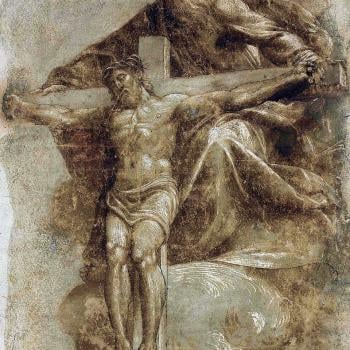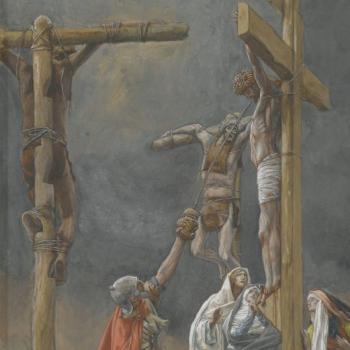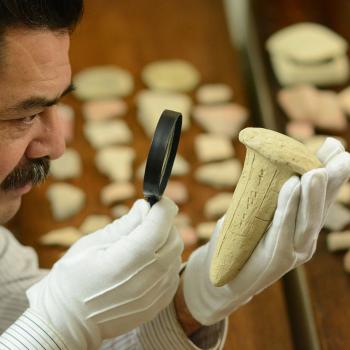
God reigns with a humane face and heart, unlike those empires and nations that rule by impersonal force. We find this theme developed in the most striking terms in Daniel chapter 7. Thomas Hieke puts it well:
Daniel 7 communicates the following message: after times of terror under the regimes of inhuman powers, a divine intervention will destroy all the violent enemies and hand over dominion and kingship to the holy ones of the Most High. Their kingdom will be an everlasting one that establishes a reign with a human face. See Thomas Hieke, “The Reception of Daniel 7 in the Revelation of John,” in Revelation and the Politics of Apocalyptic Interpretation (Waco, TX: Baylor Press, 2015), page 48.
The contrast in Daniel 7 between these impersonal forces and the humane God could not be starker. Many scholars point out that the vision of Daniel 7 builds upon the vision of chapter 2 with its focus on the four kingdoms that will arise one after another and that God will crush. In Daniel 2, the different parts of the statue about which Nebuchadnezzar dreams signify these four kingdoms. Often, they are taken to refer to the following in order: Nebuchadnezzar and the Babylonian empire (the head of gold); the Median empire (silver); the Persian empire (bronze); and the Hellenistic empire beginning with Alexander the Great (iron and then iron with clay). Here in Daniel 7:3-8, we find “four great beasts” that emerge from the sea. According to ancient cosmology and mythology in the Near East, the sea was envisioned as threatening chaos and destruction, which was symbolized by various monsters. The monsters noted here are often taken to represent the same four kingdoms presented earlier: the Babylonian empire (a lion with eagles’ wings); the Median empire (the bear with three tusks or ribs); the Persian empire (a leopard with four wings and four heads); and the Hellenistic empire (a beast with ten horns along with a little horn that emerged).
According to the United States Conference of Catholic Bishops, the fourth beast represents Alexander the Great’s empire, including the Seleucid dynasty and Antiochus IV Epiphanies:
Alexander’s empire was different from all the others in that it was Western rather than Eastern in inspiration, and far exceeded the others in power. The ten horns represent the kings of the Seleucid dynasty, the only part of the Hellenistic empire that concerned the author. The little horn is Antiochus IV Epiphanes (175–164 B.C.), who usurped the throne and persecuted the Jews.
The USCCB points out that the beast motif appears in Revelation, “where it is applied to the Roman empire, the persecutor of the Church” (Refer to Daniel 13 where a beast resembling a leopard with the feet of a bear and a mouth of a lion comes out of the sea. It was subject to a dragon who gave it power, a throne, and incredible authority, and was accompanied by a second beast that made all of earth worship the first beast).
There are different schools of thought as to how to read apocalyptic and prophetic literature. While there is certainly a place to reflect upon the distant future and God’s kingdom reign, consideration should also be given to the times in which the book of Daniel arose. As the immediately preceding quotes suggest, Daniel’s audience and Revelation’s audience were concerned primarily with threats to their own existence in the immediate context. The Seleucid dynasty and Antiochus, on the one hand, and later the Roman empire, on the other hand, certainly had an impending and direct bearing on the well-being of God’s people Israel and the Church respectively at the time of canonical composition.
Just as the beast language has elasticity and can be applied to various clear and present dangers as well as distant threats in the biblical drama, something similar can be said for the hopeful “Son of Man” language that we find in the same chapter. It reads:
I saw in the night visions,
and behold, with the clouds of heaven
there came one like a son of man,
and he came to the Ancient of Days
and was presented before him.
And to him was given dominion
and glory and a kingdom,
that all peoples, nations, and languages
should serve him;
his dominion is an everlasting dominion,
which shall not pass away,
and his kingdom one
that shall not be destroyed (Daniel 7:13-14; ESV).
The appearance of the Son of Man in Daniel 7:13-14 is taken up and applied in the canonical gospels, as well as Revelation (See Revelation 1:13 and 14:14). In the gospels, we find that Jesus often refers to himself as the Son of Man (See for example Matthew 8:20, 9:6, 11:19, 12:40, 19:28, 20:28 {cf. Mark 10:45}, 25:31, and 26:64-65). Marius Nel claims in his discussion of the “Son of Man” terminology in Mark’s Gospel that
Jesus finds in Daniel a paradigm of suffering, enthronement, and authority that he utilises to describe his own journey and interpret himself, and in the Danielic figure of the ‘Son of man’ he sees himself as the enthroned figure in the heavenly vision as the representative of the ‘saints of the Most high’ (Wright 1992:291-297). See Nel’s article “‘Son of man’ in the Gospel of Mark,” In die Skriflig, vol. 51/3 (2017): 4.
The USCCB reflects upon the difficulty in interpreting the Son of Man language in Daniel 7:
Scholars disagree as to whether this figure should be taken as a collective symbol for the people of God (cf. 7:27) or identified as a particular individual, e.g., the archangel Michael (cf. 12:1) or the messiah. The phrase “Son of Man” becomes a title for Jesus in the gospels, especially in passages dealing with the Second Coming (Mk 13 and parallels).
From my own vantage point, I see no difficulty in expanding the Son of Man language to include the people of God and the Messiah, who is their archetypal representative and Redeemer who stands in empathetic solidarity with them in the face of suffering and through whom God brings victory over the beasts for his people and the nations (See Daniel 7:18, 22, 26-27).
So, where does the preceding discussion lead us? Back to where we began. God rules with a humane face and heart, as modeled by the Son of Man, in contrast to the impersonal empires signified by the menacing beasts. The Son of Man imagery, which the New Testament identifies with Jesus, has much to teach us on how God rules and has a direct bearing on how God’s missional community should operate today.
God’s kingdom people are called to reflect God’s humane reign involving suffering with Jesus at the ‘hands’ of impersonal and oppressive rule and prophetically calling on these empires to cease with their reign of terror and show mercy to the downtrodden in view of Jesus’ eschatological reign as the Son of Man. Certainly, Daniel was forced to serve in exile as a royal official under several impersonal, imperial powers, but always in such a manner that he called on the rulers to repent of their idolatry, immorality, and oppression. No doubt, Daniel’s charge to Nebuchadnezzar in chapter 4 was reflective of his stance at all times: “Therefore, O king, let my counsel be acceptable to you: break off your sins by practicing righteousness, and your iniquities by showing mercy to the oppressed, that there may perhaps be a lengthening of your prosperity” (Daniel 4:27; ESV).
It is important to point out that the impersonal, oppressive forces were not limited to the distant past of Daniel’s time. Prophetic and apocalyptic literature involves inspired elasticity and applicability to various contexts. Take for example Daniel 7, which extends Daniel 2’s vision of the multiple empire statue imagery to the metaphorical depictions of these same empires with four ferocious beasts, likely including Antiochus IV Epiphanies who was a more imminent threat. Revelation 13 extends the beast imagery to refer to the church’s oppressor, the Roman Empire with its violent or coercive peace. In view of such elasticity involving this imagery, where might we find patterns of such beastly, impersonal rule today?
The Pax Romana (Peace of Rome) may find parallels in the Pax Britannica, Pax Americana, Pax Russica, Pax Sinica, and even the Pax Ecclesia of Christendom, and the various ‘peace treaties’ and ‘allegiances’ we form along ethnic, cultural, and individualistic lines that involve devaluing others. It is not always through military means that impersonal rule operates. Sometimes it is through simple disregard for our fellow humans, whereby community deteriorates, and we become what Dr. Martin Luther King, Jr. called “a thing-oriented society.” Here’s the full context of his statement, which includes consideration of the impersonal forces of militarism, racism, and economic exploitation in our day:
I am convinced that if we are to get on to the right side of the world revolution, we as a nation must undergo a radical revolution of values. We must rapidly begin, we must rapidly begin the shift from a thing-oriented society to a person-oriented society. When machines and computers, profit motives and property rights, are considered more important than people, the giant triplets of racism, extreme materialism, and militarism are incapable of being conquered. Martin Luther King, Jr., “Beyond Vietnam,” in A Call to Conscience: The Landmark Speeches of Dr. Martin Luther King, Jr., edited by Clayborne Carson and Kris Shepard, with an introduction by Andrew Young (New York: Warner Books, Inc., 2001), pages 157-158.
In view of these reflections on Daniel and King’s call to move from a culture of things to persons, and in view of God reigning with a humane face and heart, how might we respond?
First, guard against thinking or saying that the gospel is apolitical and come to terms with the kingdom imagery throughout the Bible. In our individualistic culture that perceives the gospel and the church solely in terms of how they benefit each of us personally, we often fail to account for the politics and kingdom reign of Jesus. We often hear talk that the gospel is apolitical, which creates a vacuum that only serves to advance the agenda of various political enterprises from across the ideological spectrum. There is no such thing as simply a gospel when it comes to Jesus. We are talking about the gospel of the kingdom—his kingdom as the royal Son of Man—which he inaugurated in his first coming and which he will bring to completion at his second advent. Jesus’ kingdom reign is very political, as it stands over, interests, and dissects the various impersonal empires and kingdoms of this world order, no matter their political stripe.
Second, make sure that we reflect what Jesus’ kingdom reign entails in our missional endeavors. As we see in the gospels, Jesus as the Son of Man reigns personally rather than impersonally. As such, he is not indifferent and impervious to our suffering and plight. What does such personal rule look like? He is humble and vulnerable. As one with a humane face and humane heart, he identifies with us in our suffering (Matthew 11:28-30). As the Son of Man, he has no place to lay his head (Matthew 8:20). He is hungry and thirsty, a destitute alien, naked, sick, and imprisoned (Matthew 25:35-36). He comes to serve rather than be served (Matthew 20:28). As the one who comes to serve rather than be served, he comes again as the one enthroned with authority to raise up the downtrodden and reward those who identify with those who are hungry, alienated, and oppressed (Matthew 25:31-40).
Third, consider ways in which we wrongly prioritize supposedly ‘missional’ endeavors over proper regard for other people. No matter how busy Jesus was in pursuing his kingdom agenda, he always engaged in a humane or benevolent way. He made time for the woman with the issue of blood, the widow whose son had died, the Samaritan woman at the well and her community, the royal official, Zacchaeus the tax collector, and many more. No amount of attention to kingdom efficiency and profitability stood in the way of the person in front of him. Like his heavenly Father, Jesus is no respecter of persons, but he did respect persons more than anyone else. Like the Sabbath, he realized that his missional kingdom was made for people, not people for the mission. Those who operate in accordance with this paradigm will always be the remnant. The impersonal forces that drive the world system force themselves upon us, and we must wage war with ourselves in the depths of our spirits in and through Jesus and God’s Spirit to serve in humane ways. May we never operate like the impersonal beasts of Daniel 7, but like the Son of Man, knowing that God always rules with a humane face and heart.
*This is the seventh post in a series featuring how to be faithful in our witness to God while experiencing the threat and reality of spiritual exile. For the previous post, refer here.












